New York Transit Museum facts for kids
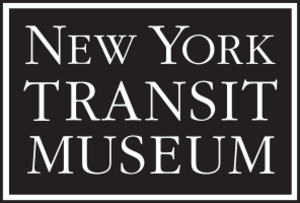 |
|||||||||||||||||||||||||||||||||||||||||||||||||||||||||||||

Side view of the street entrance on the corner of Boerum Place and Schermerhorn Street
|
|||||||||||||||||||||||||||||||||||||||||||||||||||||||||||||
The New York Transit Museum (also known as the NYC Transit Museum) is a cool place that shows off the history of New York City's public transportation. This includes the famous New York City Subway, buses, and commuter trains. The main museum is located inside an old subway station called Court Street in Brooklyn. There's also a smaller part of the museum inside Grand Central Terminal in Midtown Manhattan. The museum is part of the Metropolitan Transportation Authority (MTA). ContentsThe Museum's Home: An Old Subway Station
The New York Transit Museum is special because it's built inside a real, old subway station! This station was originally named Court Street. It opened on April 9, 1936. It was meant to be the end of the line for local trains on the IND Fulton Street Line. The station has one platform in the middle, with two tracks on either side. The tracks end at special "bumper blocks" right after the platform. The station walls are decorated with cool aquamarine tiles and a blue border. Even though it's a museum now, it's still a working subway station. Trains are moved in and out of the exhibits using tunnels that connect to the nearby Hoyt–Schermerhorn Streets station. Why the Station ClosedThe Court Street station was designed for local trains to run within Brooklyn. Passengers were supposed to transfer to express trains to go to other parts of the city. However, the special train service planned for Court Street never really started. The only trains that used the station were part of a short shuttle service that went to Hoyt–Schermerhorn Streets. Because there were other subway stations very close by in Downtown Brooklyn, and because you had to transfer to get to Court Street, not many people used it. So, the station was closed on June 1, 1946. Closing it saved the city about $19,903 each year. At the time it closed, the shuttle only made about $6,700 a year. After it closed, most of the entrances to the street were sealed up. What Happened After It Closed?Even though the station was closed to the public, trains without passengers would sometimes run through it. This was done to "keep the rails polished." In 1960, the New York City Transit Authority even tested new cleaning methods on the station's walls. There were also ideas to turn the old station into a bowling alley in 1961, but that never happened. The sealed entrances sometimes became places where people would dump trash. The station also became a popular spot for filming movies! In 1949, it was used for the movie Guilty Bystander. In 1956, a scene for The FBI Story was filmed there, pretending to be the Bowling Green station. By the 1960s, the station was used for many films every year. For example, it was a filming spot for nine movies in 1964, thirteen in 1965, and twenty-two in 1966. The famous movie The Taking of Pelham One Two Three (1974) also used the station. Even after the museum opened, it's still used for filming and private events when the museum is closed. How to Get InThe main entrance to the Transit Museum is at the corner of Boerum Place and Schermerhorn Street in downtown Brooklyn. To make it easier for everyone to visit, a special chair lift and elevator were added after it became a museum. These features help people using wheelchairs. You usually need to request the wheelchair lift in advance or use a call button. What You Can See and DoThe New York City Transit Exhibit first opened on July 4, 1976, as part of the United States Bicentennial celebration. Back then, it cost just one subway token to get in! They showed off old subway cars, models, and other cool exhibits. It was supposed to be open only for a few months, but it was so popular that it became a permanent museum. In the mid-1990s, the Metropolitan Transportation Authority (MTA) took over the museum. They decided to include other types of transportation from the New York area, like commuter trains (Metro-North, Staten Island Railway, Long Island Rail Road) and even roads, tunnels, and bridges. So now, you can often see exhibits about these topics too. The museum has lots of interesting things, including:
They also offer talks, workshops, films, and tours for all ages. Sometimes, they even have special tours of MTA buildings, subway stations, and New York neighborhoods. You might even get to ride on some of the old trains and buses! The upper level of the museum has most of the exhibits, restrooms, and a gift shop. You'll find artifacts from old subway and bus operations, as well as New York City's transportation buildings. These exhibits change sometimes. There's also a small room where they show videos about being polite and safe on public transport. The museum sometimes works with other local groups, like the Coney Island Museum, to put on special shows. Cool Old TrainsDown on the platform level, there are two working subway tracks filled with many historic New York City subway and elevated railway cars. These old trains are on permanent display. Some of them can still be driven! They date back to the very first subway companies, like the BMT and IRT, and the city-owned IND. One of the platforms has special yellow "gap filler" boards. These boards can be extended to let people safely get on the narrower IRT trains, which were built for older lines. You can also see some special vehicles that were used for maintaining the tracks. On the platform, there's a large wheel and motor (called a bogie) on display. There are also signs that explain how New York City's rail systems developed. Another cool thing to see is a fully working underground "signal tower" control room. This room was used to control the trains on the IND Fulton Street Line and IND Crosstown Line when the station was open. The lights and control levers still work! They are used when the museum needs to move or replace the subway cars on display. Because the controls are live, the panel is locked, but you can still look through a window and read about it. Other items in the museum include a poster for the 1926 movie Subway Sadie, and an original brass light fixture from when the station was open. You can also see an original mosaic plaque from the 137th Street station, which dates back to the subway's opening in 1904. Historic Bus Collection
The 26th Annual Bus Festival in Brooklyn Bridge Park
Besides subway cars, the museum also has a large collection of old buses. Since there's no space to show them all underground, they are stored in different bus garages around the city. They come out for special events, like the museum's yearly "Bus Festival." This festival happens every year with the Atlantic Antic street fair. During the Bus Festival, the museum lets everyone in for free! Some of the buses in the collection include:
You can also see some bus-related items in the museum. For example, there's an old "revenue bag" that bus drivers used in the 1950s to carry money from the buses. This is part of an interactive exhibit where you can see how money was collected from the fare boxes. What's On Display NowAs of 2017, the museum has several interesting exhibits:
Turnstiles and How We PayThe museum has many different turnstiles from the subway's history. Some are from when the subway first opened in 1904, and others were used as recently as 2003. There are even turnstiles from the 1939 New York World's Fair that made people pay twice! This exhibit is interactive, and you can walk through most of the turnstiles. There's also a display of the different subway tokens used before the MetroCard came along. The Subway Car CollectionMost of the subway cars in the museum's collection can still be operated. They are often used for special "Nostalgia Trains" that the museum runs on different parts of the subway system. These cars are decorated with old advertisements and maps, making them feel like you've stepped back in time. You usually need to buy tickets in advance for these special trips. However, some special trains, like Holiday specials, are open to anyone who pays the regular subway fare. Besides the cars in the museum, many others are stored in subway yards, waiting to be fixed up or displayed. Here are some of the cars you can see in the museum as of August 2025:
More Subway Cars in the CollectionMany other cars are not always on display but are used for special fan trips and events. Most of these are kept at the 207 Street or Coney Island Yards.
Gallery of Subway Cars
Grand Central Gallery Annex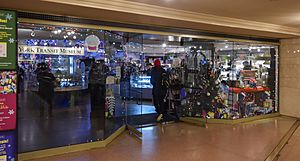
Grand Central Terminal Gallery Annex and Store
The New York Transit Museum also has a smaller gallery and store at Grand Central Terminal. It opened on September 14, 1993. This spot has a gift shop with transportation-themed items and a space for temporary exhibits that change often. The Annex is also where the museum holds its yearly Holiday Train Show, which features a cool working model train layout. While there's a fee to enter the main museum in Brooklyn, it's free to visit the Annex at Grand Central. The main Brooklyn museum also has its own gift shop. Museum ArchivesThe museum keeps many important documents, photographs, and artifacts in its archives. These help preserve the history of transportation in New York. Researchers can visit the Archives through the museum. Some items from the museum's archive can even be seen online on the New York Transit Museum's Online Collections platform or on Historypin. See also
|
|||||||||||||||||||||||||||||||||||||||||||||||||||||||||||||


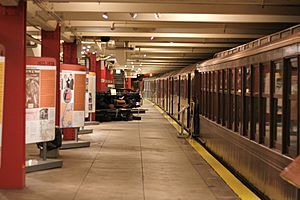
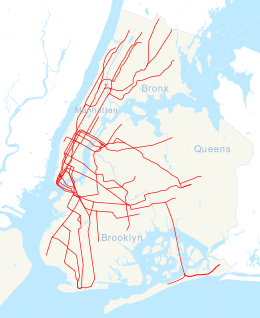
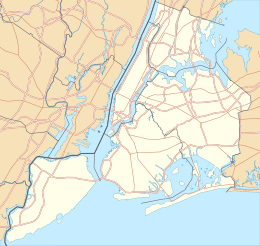
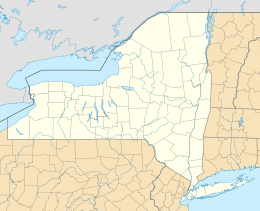


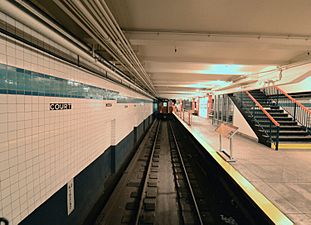
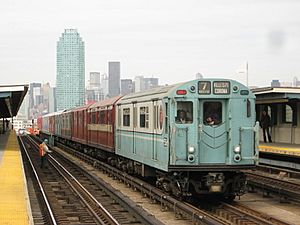
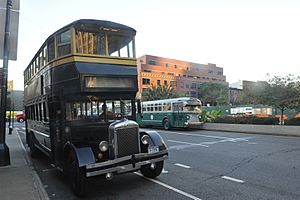
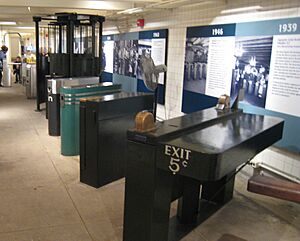
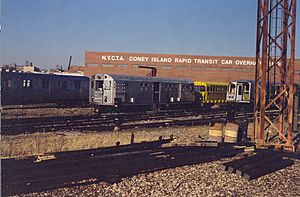
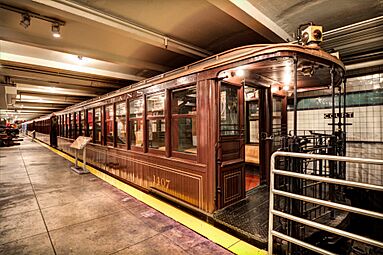

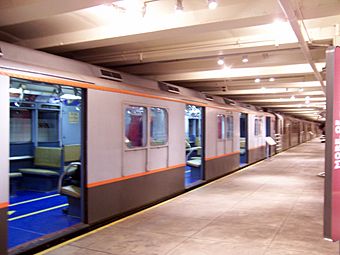

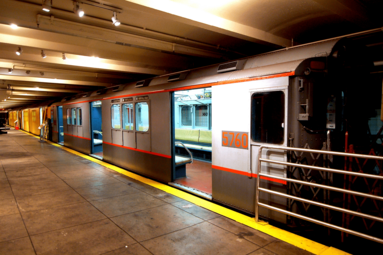


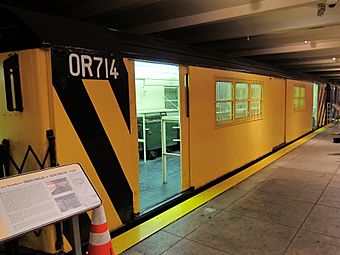

 In Spanish:
In Spanish: